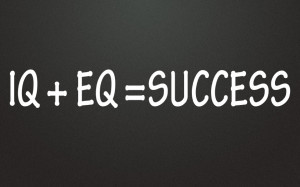Mary E. Marshall's Blog, page 36
May 6, 2015
Leadership: The Ideal Factor
 “The Ideal Factor” – a shared intent by everyone in the business to improve people’s lives – keeps renewing and strengthening great businesses through good times and bad.
“The Ideal Factor” – a shared intent by everyone in the business to improve people’s lives – keeps renewing and strengthening great businesses through good times and bad.
– Jim Stengel, Grow: How Ideals Power Growth and Profit at the World’s Greatest Companies, 2011
Do you have an Ideal Factor in your business? According to Stengel, if you do, the results will be somewhere in the neighborhood of 300-400% over competitors who don’t. His book, “Grow” is a good read and has a lot of good points in it and I think it aligns closely with what I consider the value of “declaring an intentional culture that is aligned with one’s personal and professional values.”
The difference in his “Ideal Factor” is that if you do something that improves people’s lives, that shared vision will lead people to coalesce around the vision and, therefore, create better returns for the company. Obviously that is one reason to do it, but I think the larger and more compelling reason is that it’s why people want to work at companies. People have a need to make a difference and the more accurately you can tell your company’s story as it relates to improving people’s lives, the more compelling your company will be to work for.
However, before you can have an “Ideal Factor,” I think you must be clear on your values. The ideal needs to sit on top of that foundation and without it, may not hold much substance. It’s great for everyone to agree that they believe in the “ideal,” but what shared values are holding that ideal up? For example, values such as trust, opportunity, and caring can mean different things depending upon the “ideal” the organization is aiming for and without matching the two – the ideal and the values — you will have different interpretations.
Without understanding the values that support an ideal, it’s also hard to hire those who are aligned with where you are going. As Simon Sinek says, values drive beliefs, beliefs drive behavior, behavior drives results and results drive performance. The ideal or “mission” is what we’re trying to accomplish, but “why” we’re doing should be shared values. Clarity around those values will support the Ideal Factor through good times and in bad.
Stengel’s research and argument are compelling and I think it would be a mistake to ignore the results of the companies studied. I would just take it one step further and identify those values that bind the team together to achieve the ideal factor. It’s what the current and future workforce is looking for – the opportunity to contribute to an organization and feel that they are doing meaningful work.
The post Leadership: The Ideal Factor appeared first on Mary Marshall // CEO Coach.
April 28, 2015
Leadership Character = 5x Return on Assets
 What is “Leadership Character?” According to Fred Kiel’s recent book, Return on Character, the following are the top 8 character traits of great leadership:
What is “Leadership Character?” According to Fred Kiel’s recent book, Return on Character, the following are the top 8 character traits of great leadership:
Displayed and demanded high moral principles.
Embraced a worldview of positive beliefs.
Developed a higher level of mental complexity.
Sought out and listened to critical feedback from others.
Found and enjoyed the company of one or more mentors.
Demonstrated the ideas and behaviors of self-determination.
Virtuoso leaders know their life story.
Sought and accepted help from many supportive people since childhood.
Interestingly, these are not dissimilar to the characteristics discussed in my last two blog posts. Bottom line is good leadership leads to growth in organizations and a return on assets for the investors. Kiel interviewed over 100 CEOs and was able to quantify it to a return of 5 times – much higher than most would have guessed.
I’ll take the concept of Leadership Character one step further and say that it ties into one’s values. It’s all about living those inside and outside the organization. Although I work with leaders on a daily basis, I continue to be surprised when I ask the question, “what are your values?” how few people can answer in a succinct manner. We usually get there after some discussion, but if Kiel’s research is correct, it’s important for leaders not only to know their values, but be able to craft a story that communicates them clearly.
People WANT to follow leaders they believe in and who believe in them. The best way to share that is through your story. We are humans and we understand “stories” better than any pitch on earth. We see ourselves in stories. We identify with the values being shared and we form a belief about the character of the person in the story.
In addition to knowing one’s story, knowing that you need more information, that you may not always be right, and that the best solutions are those reached collectively, also seem to be common traits of leadership character. This is why good leaders are always looking for “other opinions” both from within and without the organizations. Of course, implementation or execution is the place most organizations get tripped up, but when the “plan” has been collectively decided on, the chances of successful implementation are definitely increased.
Lastly, leaders who have good character, look for mentors. Mentors provide them with additional information, feedback, and inquiry so they can be the best they can be. Mentors also hold them accountable, which good leaders seek out.
When you think about your Leadership Character – are you clear about your values? Your story? Do you have a mentor? If you take a little time to think about it and adopt these traits the benefits to your organization could be as much as 5x the return on investment.
The post Leadership Character = 5x Return on Assets appeared first on Mary Marshall // CEO Coach.
April 22, 2015
Top Performers = Good Leaders? Not So Fast.
 How many times have you promoted your best performers only to see them struggle as a manager or leader? A client recently promoted his top sales person to lead the team and the entire team’s performance went down double digits. Why does this happen and what should you watch for?
How many times have you promoted your best performers only to see them struggle as a manager or leader? A client recently promoted his top sales person to lead the team and the entire team’s performance went down double digits. Why does this happen and what should you watch for?
A recent piece from Fast Company highlights 5 common reasons this phenomenon happens:
Lack of leadership skills
They are not team leaders
Lack of engagement
They get bored easily
Personal vs. team goals
The first assumption we make is that good performers are good leaders, when in fact leadership skills are important, but undervalued on a regular basis. It would be like making the assumption that a top car mechanic can also run the kitchen. They are not related at all. As I mentioned in my blog, “Can Leadership Be Learned?” I believe you must have some natural talent at it and then learn the best practices that make a good leader. If a performer has not volunteered to run a project, or to engage other teammates, they might not be a good leader, nor have any interest in it.
We are taught to “get ahead” and that means moving up the ladder in an organization and at some point that involves managing others. However, we are rarely given any instruction as to what that looks like, what good leadership is, or how to do it well.
The next reason that top performers aren’t necessarily your best leaders is a “lack of engagement.” We assume that because they do well, they are engaged. A recent study showed that a full 42% of top performers were unengaged. And not only that, but they did not feel supported by management and were looking for other opportunities.
There is also the reality that top performers get bored easily. They like new challenges and trying new things, leading, and in particular managing, can be tedious and if someone on their team is not learning quickly enough for them, they will get impatient and bored with the whole process. These types of performers assume that everyone is as smart as they are and should be equally capable of producing results. The have little tolerance for differences in strengths and skill sets and get bored dealing with others that are not like them.
The last reason cited is top performers are more focused on personal goals than team goals. It’s easier to get there by yourself, much harder as a group.
A true leader has all of the above missing characteristics, and sometimes they are top performers, but more often they aren’t. They are your good performers who are team players and have a knack for listening, coaching, mentoring and crossing the finish line together. They are not the top performers who are really solo artists who never look to see who is behind them.
photo credit: Indoor Track – New York – Ivy Prep League, Meet 4 via photopin (license)
The post Top Performers = Good Leaders? Not So Fast. appeared first on Mary Marshall // CEO Coach.
April 14, 2015
Emotional Intelligence – Good Leaders Have It
 A great piece in the New York Times last week by Daniel Goleman was an excellent reminder about what good leadership is and isn’t, and it definitely includes developed emotional intelligence. Although emotional intelligence, (or EQI as it is commonly referred to), has many components, Goleman talks about the top 4 competencies that good leaders exhibit.
A great piece in the New York Times last week by Daniel Goleman was an excellent reminder about what good leadership is and isn’t, and it definitely includes developed emotional intelligence. Although emotional intelligence, (or EQI as it is commonly referred to), has many components, Goleman talks about the top 4 competencies that good leaders exhibit.
#1 Self-Awareness
Self-awareness is about understanding not only your own strengths and weaknesses, but your feelings as well. A good deal of leadership is about understanding what you are NOT good at and picking the best person to fulfill those duties or responsibilities. However, a lot of leaders have a hard time with this because their ego does not allow them to say they do anything poorly or at least not as good as someone else. The other piece that gets in the way is when leaders feel the need to hang on to everything and refuse to delegate, thus depriving others of success and keeping themselves stuck in a destructive cycle that can hurt them and the company. Doing it ALL, is not good leadership. It might get things done, but at a great cost both personally and professionally. Good leadership is about acknowledging one’s skills and feelings honestly and hiring others to do what is not your “best” strength.
#2 Self-Management
The next competency that emotionally intelligent leaders exhibit is self-management. This is defined as the ability to stay calm under pressure and not panic, or overshare your feelings and be a reassurance for people during crisis, (as opposed to the leader who pours lighter fluid on an already raging fire). This is the ability to calmly discuss problems and find solutions, and dealing objectively with issues versus reading meaning into every action. Additionally, it’s the ability to self-motivate – to decide on the course and move ahead, regardless of setbacks. Good leaders do this naturally and people feel safe working for them. They don’t worry about what the boss’s mood might be today and feel pressured to adjust accordingly.
#3 Empathy
The third competency is empathy. This is a highly underrated competency and is often associated with being weak. However, it is much harder to try and understand someone’s perspective than to just adopt your own and move on. Empathy requires good listening skills and an ability to make others feel heard and valued. An empathetic leader will often be called a good communicator. In addition, as with good self-management skills, people will feel safer with a boss who is capable of empathy.
#4 Relationship Skills
The last competency is relationship skills. This is marked by the ability to be persuasive and communicate in ways that motivate people. People feel relaxed around you and often laugh. It’s very hard to get people to do things when they don’t like you and feel disrespected. It’s very easy when they like you and want to be involved. They feel respected and often laugh and have fun. Some leaders may be the best strategists in the world, but if they can’t or don’t motivate the team to follow, it’s just another strategy on paper.
As a leader, how is your development in each of these four competencies? If you need a little work, you’re not alone. At CEO Global Network, we offer an EQI assessment to all of our members because we feel so strongly that it is at the foundation of good leadership. All of our Group Leaders also go through this assessment and are trained to develop their EQI as well.
We know that working with others in a confidential setting focused on development is an excellent way to work on your EQI skills. You can learn more here.
The post Emotional Intelligence – Good Leaders Have It appeared first on Mary Marshall // CEO Coach.
April 8, 2015
Can Leadership Be Learned?
 Duff McDonald wrote a great piece in the New York Times today debating whether or not one can be taught to lead. As he says, all of the big business schools say it in their mission statements and taglines – “developing leaders who make a positive difference in the world,” (University of Michigan’s Ross School), or “leaders who make a positive difference in the world,” (Kellogg at Northwestern), etc. The messages all sound about the same.
Duff McDonald wrote a great piece in the New York Times today debating whether or not one can be taught to lead. As he says, all of the big business schools say it in their mission statements and taglines – “developing leaders who make a positive difference in the world,” (University of Michigan’s Ross School), or “leaders who make a positive difference in the world,” (Kellogg at Northwestern), etc. The messages all sound about the same.
But can leadership or being a leader be learned like algebra? I don’t think so. I think you can learn what a good leader looks like, who they are, how they inspire, and what they’ve done. I think you can learn how to “manage” a good company, but leading is a whole different animal. You’ve no doubt read the definitions for the two, managers take care of the operations, leaders provide the vision and the inspiration to act on something. The leader is the general who decides the strategy (usually not alone), and inspires others to follow the vision. Managers do not necessarily inspire but manage, monitor and operate or execute on the vision. Business school is usually about teaching what good management looks like, not how to lead.
So if you can’t get it in school, where does it come from? Like most other strengths that become talents, it’s something you have innately and is honed by your experiences and desires. From your earliest memories, I’m sure you can recall those fellow students who were “leading” or always were nominated to lead because they inspired something in others. There were also those who wanted to “manage” the process, the crowd, the purpose and in some cased their reputations to get ahead. These were and are not leaders.
It’s very similar to anyone who is at the peak of their field, a good athlete, musician, politician, etc. They have a natural talent for something and then through practice, and experience get better at it. Leaders are similar, but also different. Different because there is really not a way to “teach” it. They come with talent for inspiring people, knowing how to read people and helping coalesce an idea for the common good or purpose. They are humble, willing to change when needed, but passionately believe in something. They come in all different flavors, JFK and Rosa Parks are two examples. JFK, because of family of origin and privilege was in a position to lead and he did. Most remember him as inspirational, (although that has become tarnished a bit over time as some of his other behaviors have come to light). Rosa Parks was also inspirational and through one small act or courage to stand up for what was right, changed the course of history. That’s leadership in action and it can’t be taught in school.
Some get in positions of leadership that have no business being there. They are tyrants, dictators or just inept. True leadership starts with a strength and over time and through experience becomes a talent. Entrepreneurs are thrust into leadership positions. The wise one knows whether or not he or she is a good leader and hands the role of leader to someone else if they are not.
The post Can Leadership Be Learned? appeared first on Mary Marshall // CEO Coach.
April 2, 2015
Depression and the Entrepreneur
 A recent series in the Puget Sound Business Journal told the stories of several tech startup CEOs and their bouts with depression. It discussed the extreme focus on the business, to the exclusion of all else, that led to the depression and the consequences. Anyone who has started a business knows this can and will likely happen. It’s a matter of how deep you go and how quickly you can get out of it.
A recent series in the Puget Sound Business Journal told the stories of several tech startup CEOs and their bouts with depression. It discussed the extreme focus on the business, to the exclusion of all else, that led to the depression and the consequences. Anyone who has started a business knows this can and will likely happen. It’s a matter of how deep you go and how quickly you can get out of it.
I think tech companies are particularly prone to this because the nature of the work is largely “solo.” They code until they can no longer keep their eyes open and wake up to do it all over again. Such concentrated focus can produce results, but at what cost? In the case of the CEO of Moz, Rand Fishkin, he ended up stepping down after a serious bout with depression.
However, even if you don’t have a tech startup, leading any entrepreneurial venture can be lonely and isolating. I have two ideas that I’ve seen helpful to prevent this from happening.
Should the Founder Remain the Leader?
First and foremost, the founder needs to determine whether they are indeed the one to “lead” the company. I discuss this at length in Chapter 2 of my book, The Entrepreneurial Puzzle. In a nutshell, not everyone is cut out to lead. Founders are idea people and that doesn’t necessarily mean they are good leaders. In fact in most cases, they are not. Just because someone was the top of the class as an architect, doctor, programmer, scientist, engineer, does not mean they should lead. The further they go down the road as CEO or leader, the more uncomfortable they are and the more pressure to make decisions is piled on. Now the work they were doing on the product or service is compromised AND their effectiveness to lead others on the project or vision diminishes greatly.
The sooner the founder discovers what I commonly refer to as “only do what only you can do,” the more successful they will be. Being CEO is a full-time job. Doing it while building the “plane” is equivalent to flying it while it’s being built. This usually results in a crash.
Leverage the Support of Peer Advisory
The second idea is to use a peer advisory group to check your backswing. With all the stress of the late hours, no balance, and dogged determination, who is going to tell you that you’re seriously heading for that crash? Who is going to offer to help without asking for payment? Your fellow CEOs who are in the same boat as you and want to help as much as they want help from you. Don’t go it alone. Obviously I have a bias here as the President of CEO Global Network, Western US, but that bias is based on many years of experience. I know firsthand what peer advisory can do to help leaders avoid falling into that pit of depression. And beyond helping prevent depression, how about increasing the odds of your success from 10% for most startups to closer to 40-50%? If you were betting wouldn’t you want the second set of odds? The support and solutions you need are just a CEO group away.
photo credit: Teesmouth Ragnarök via photopin (license)
The post Depression and the Entrepreneur appeared first on Mary Marshall // CEO Coach.
March 25, 2015
Getting Things Done or Doing the Right Things
 To quote Warren Bennis, “Managers do things right and leaders do the right thing.” The reason I bring this up was a recent conversation I had with a manager. He was telling me about all the work he had done and was frustrated because there was still so much more to do and no one noticed his hard work. I am sure he was doing things right, but my question to him was whether or not he was working on the right things? He looked at me a bit puzzled and said “of course, these are all the things that have to get done.” Then I asked why they needed to be done, how did they fit into the overall plan for his department and consequently into the larger plan for the company.
To quote Warren Bennis, “Managers do things right and leaders do the right thing.” The reason I bring this up was a recent conversation I had with a manager. He was telling me about all the work he had done and was frustrated because there was still so much more to do and no one noticed his hard work. I am sure he was doing things right, but my question to him was whether or not he was working on the right things? He looked at me a bit puzzled and said “of course, these are all the things that have to get done.” Then I asked why they needed to be done, how did they fit into the overall plan for his department and consequently into the larger plan for the company.
As you might imagine, he didn’t have a ready answer, but after a few minutes of thought he started to get the idea. We looked at the entire list of all the tasks he thought he needed to accomplish and tried to determine if indeed they were the right things. Obviously, some of them had to be done to keep the business on track. Others simply didn’t need to be done, but were habitual routines that had not been looked at for some time and no longer served any real purpose. Then there were those tasks that indeed were the right things to move the organization forward on the strategic plan.
After this review the list of “to dos’” dropped dramatically and more importantly, he was able to carve out time for the things that were important to the leaders of the organization. Next, we talked about how he was managing his direct reports. Were they working on the right things? He suspected they were doing exactly as he had been doing and so he went through the same exercise with each of them.
Not surprisingly, things really started to hum at the company after this and the CEO was very impressed with the performance of his managers and said so. It is important to consistently review and check processes for improvement opportunities. Periodic reviews are critical to confirm if tasks and steps still make sense over time, and if what is being done is still relevant and related to the right things for the organization. So often, we get lulled into just getting stuff done without really thinking about whether or not these tasks are optimal or even important. I for one, love crossing things off my to-do list, but it often puts me no closer to my goals. So I look at my weekly list now and only put those things down that move the needle forward and truly have to be done.
As a leader, your direct reports will mirror what you do. Make sure you are working on the right things so that they are too.
The post Getting Things Done or Doing the Right Things appeared first on Mary Marshall // CEO Coach.
March 12, 2015
Vision, Passion and Perseverance
 I was having coffee with a friend and colleague of mine today, Dr. Julie Miller, and she was talking about her new venture. She’s had a very successful career and found that she wanted to do more. Last year she created a program that really inspires employees to access that “self-starter” gene and take some initiative within companies to make a difference.
I was having coffee with a friend and colleague of mine today, Dr. Julie Miller, and she was talking about her new venture. She’s had a very successful career and found that she wanted to do more. Last year she created a program that really inspires employees to access that “self-starter” gene and take some initiative within companies to make a difference.
What intrigued me most about her topic was that she starts with three very clear premises, Vision, Passion and Perseverance. Of course, I’ve talked a lot about Vision and Passion and that one without the other doesn’t work. I believe that you must have both to achieve your dreams, but she adds the component of Perseverance. She’s not as interested in entrepreneurs as I am. Her interest is in large corporations harnessing the self-starter in everyone and by doing so the organization will thrive. She helps employees to connect to the organization’s Vision, (I would venture to say that most can’t), then connect to their Passion and why they are there. She then asks them to see how the company has persevered in spite of circumstances to achieve the Vision.
There are a lot of learning moments in this exercise. I think the question for entrepreneurs is – how would your employees respond to this? All of these items are the basis for your organization’s culture, and if they don’t have an answer, they’re making one up that is not a reflection of what you originally intended. It might be worth it for you to do a little informal survey and ask employees what your vision is and why are you passionate about what you do? How do you think they will respond? At minimum, your management team should have the right answers. If they don’t, it’s time to rethink how you are communicating these critical messages.
You, the entrepreneur and leader are the shepherd of the Vision. If your flock doesn’t follow, you have problems. It’s your passion that will inspire theirs. And if they can’t answer how the company has persevered or weathered through hard times or crisis, how do they know what the real heart and soul of the company is? Employees want to know you’re here to stay and that they have some sense of security. The old model of the stoic leader that keeps all the bad news to him or herself is not allowing the team to help, nor learn from adversity, and more importantly, not allowing them to see how the company has persevered in service of the Vision.
So you want self-starters and initiative on your teams? Make sure they have the basic ingredients to generate it – Vision, Passion and Perseverance.
photo credit: Where there’s a will there’s a way via photopin (license)
The post Vision, Passion and Perseverance appeared first on Mary Marshall // CEO Coach.
February 26, 2015
Mental Strength – Do You Have It?
 An excellent article was just reposted in Forbes: “Mentally Strong People: The 13 Things They Avoid,” by Amy Morin. Talk about a great list for all of us to remind ourselves about, but especially true for entrepreneurs! These are the things mentally strong leaders don’t do:
An excellent article was just reposted in Forbes: “Mentally Strong People: The 13 Things They Avoid,” by Amy Morin. Talk about a great list for all of us to remind ourselves about, but especially true for entrepreneurs! These are the things mentally strong leaders don’t do:
Waste time feeling sorry for themselves
Give away their power
Shy away from change
Waste energy on things they can’t control
Worry about pleasing others
Fear taking calculated risks
Dwell on the past
Make the same mistakes over and over
Resent other people’s success
Give up after failure
Fear alone time
Feel the world owes them anything
Expect immediate results
Obviously, we all fall into some of these occasionally, but the true entrepreneur does not spend any significant time in the mentally weak areas. It’s a waste of time and doesn’t move the needle forward.
Having worked with entrepreneurs for over 20 years and having been one myself, I believe the difference between success and failure can be any one of these pitfalls. We all have at least one or two that can be our Achilles heel. Personally I suffer from #5, worrying about pleasing others, and #13 expecting immediate results. It’s funny to see all of the things I’ve seen entrepreneurs get stuck on over the years in one list. It’s not about strategy or money. It is the mental strength in these 13 areas that get you through.
I’m in the build process right now for my new venture, CEO Global Network – Western United States, and as is the nature of a start-up, all has not gone according to plan. However, once I got over my need to please everyone and expecting immediate results, I revamped the plan and we’re off to the races again! Even though I know this stuff, I teach this stuff, and I see this stuff, it’s hard not to fall into it yourself. As we discuss in CEO Global Network, good leaders have high Emotional Intelligence, starting with Self-Awareness. So although these two pitfalls may always be my issues, I am becoming much better at spotting them and getting through them quicker, (and yes, that is my need for immediate results. J)
So what is your Achilles heel? Which one of the 13 keeps you up at night and is blocking you from achieving the business success you want? I know it’s not all 13 or you wouldn’t even be reading this and I doubt it’s more than a couple, or you wouldn’t be an entrepreneur. If you aren’t sure, ask those that work for you, or your spouse, or partner – they’ll know and they’ll be right. As with any bad habit, (and that’s all these are), you can replace it by first identifying it and then creating a new behavior that is the opposite. Try it for 30 days and see if you and those around you see a difference. I’ll bet they do.
The post Mental Strength – Do You Have It? appeared first on Mary Marshall // CEO Coach.
February 19, 2015
Employee Engagement = ROI
 Last week I discussed why employees are more productive with praise vs. punishment. When people “feel” better they perform better. This week I saw an op-ed piece from the NY Times, “Why You Hate Work,” which seemed like a great follow-up to last week’s blog. I think this article has some excellent research about employee engagement which is so important to both the top and bottom lines.
Last week I discussed why employees are more productive with praise vs. punishment. When people “feel” better they perform better. This week I saw an op-ed piece from the NY Times, “Why You Hate Work,” which seemed like a great follow-up to last week’s blog. I think this article has some excellent research about employee engagement which is so important to both the top and bottom lines.
The researchers say only 30% of all employees feel engaged at work. This means that a full 70% of your workforce is NOT engaged during their working hours. Essentially, you are not getting a very good ROI on the wages you are paying for 70% of your workforce.
They identified four core employee needs that impact engagement:
Physical: through opportunities to regularly renew and recharge at work
Emotional: by feeling valued and appreciated for their contributions
Mental: when they have the opportunity to focus in an absorbed way on their most important tasks and define when and where they get work done
Spiritual: by doing more of what they do best and enjoy most and by feeling connected to a higher purpose at work
Not surprisingly, when these needs are met, performance and productivity go way up as does loyalty, job satisfaction, and positive energy while stress goes down. The researchers also found that when one need was met, compared to none, all performance variables went up. It just continued to go up from there as more needs were met.
In most workplaces, addressing all of these would be a profound cultural shift, but as with any investment in business, you need to assess the ROI of doing so. If we agree that 70% of our employees time is spent “disengaged,” then I would suggest that the ROI could be HUGE. Even if you could get that number up to 50% engagement, you would see many positive benefits. And remember that in a workplace, when a positive shift happens, many more will follow because basically humans are wired that way.
So if you can’t spring for free food, flexible work shifts, and have no time or money to spend on consultants to help you figure out best first steps, start small. The article talks about the value of intermittent rests, 10-15 minutes for every 90 minutes worked, and how much more productive everyone is when this is the standard. Just declare that no meeting will go longer than 90 minutes to start and then figure out how to integrate the rest of the changes into your culture and practices.
Just to give you an idea of how valuable this is let’s consider Costco. They put their people first, paying on average 65% more than Walmart, which owns Sam’s Club. Costco’s employees generate twice the sales of Sam’s Club and they have only a 5% turnover of employees who stay at least a year. The reduced recruiting and training costs save Costco several hundred million a year. How is that for a positive ROI?
Think about changing your programs, policies and practices to truly become employee-centric – it’s not nearly as hard as it might seem and the rewards are far above investing in another piece of equipment or consultant.
The post Employee Engagement = ROI appeared first on Mary Marshall // CEO Coach.



